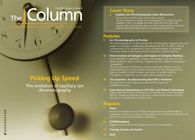HPLC–MS–MS Detects Insecticide Degradates in Baby Food
Scientists from Emory University (Georgia, USA) have developed a new solid–phase extraction (SPE) method to isolate four insecticide degradates from baby food for analysis by high performance liquid chromatography tandem mass spectrometry (HPLC–MS–MS). The paper published in the Journal of Agricultural and Food Chemistry describes how the method can be applied to differentiate between exposure to insecticides or preformed degradates.
Scientists from Emory University (Georgia, USA) have developed a new solid‑phase extraction (SPE) method to isolate four insecticide degradates from baby food for analysis by high performance liquid chromatography tandem mass spectrometry (HPLC–MS–MS)(1). The paper published in the Journal of Agricultural and Food Chemistry describes how the method can be applied to differentiate between exposure to insecticides or preformed degradates.
Analysts typically sample urine and test for the presence and concentration of organophosphorus and pyrethoid insecticide metabolites to determine insecticide exposure, assuming that there is a correlation between intake and excretion. One problem with this approach is that breakdown products can already be present on food and exposure can be overestimated. Samantha Radford, coauthor of the paper, told The Column: “Exposure scientists often quantify a person’s insecticide exposure by measuring urinary insecticide metabolites. This assessment relies on the presupposition that this person is exposed only to the parent compound and not to any insecticide metabolites preformed in the environment, which we term insecticide degradates. There are few studies exploring whether these preformed degradates exist in the environment, so we currently don’t know whether or not that is an accurate assumption."
The method was developed to measure degradates in baby food including malathion dicarboxylic acid [malathion]; 3,5,6-trichloro-2-pyridinol [chlorpyrifos, chlorpyrifos methyl] (TCPy); cis/trans-3-(2,2‑dichlorovinyl)-2,2‑dimethylcyclopropane-1-carboxylic acid [permethrin, cypermethrin, cyfluthrin]; and 3-phenoxybenzoic acid [general pyrethroid]. Two brands of baby food sold in the USA were sampled, and included green beans, carrots, peas, apples, bananas, and pears. Organic branded foods were used for method validation and spiked samples demonstrated method accuracy. Samples were prepared using SPE, before they were analyzed by HPLC–MS–MS with an electrospray ionization interface (ESA).
Recovery rates were between 80–120%. MDA, TCPy, and DCCA were found in all baby food, including some organic foods. Analytical degradation of insecticides was ruled out as being statistically insignificant. Radford said: “The method we present in Journal of Agricultural and Food Chemistry causes no statistically significant analytic degradation; therefore, we can feel confident that any degradate we find comes from preformed insecticide metabolites in the food and not from degradates formed during the extraction or chromatographic process.” She added: ”As far as advantages go, the main one is that there are very few methods currently available to extract these compounds from food. Of those that exist, we do not know if they cause bias due to analytic degradation of parent pesticide.“ - B.D.
Reference
1. S.A. Radford, P. Panuwet, R.E. Hunter, D.B. Barr, and P.B. Ryan, Journal of Agricultural and Food Chemistry DOI: 10.1021/jf500779a (2014).
This story originally appeared in The Column. Click here to view that issue.

New Study Reviews Chromatography Methods for Flavonoid Analysis
April 21st 2025Flavonoids are widely used metabolites that carry out various functions in different industries, such as food and cosmetics. Detecting, separating, and quantifying them in fruit species can be a complicated process.
Analytical Challenges in Measuring Migration from Food Contact Materials
November 2nd 2015Food contact materials contain low molecular weight additives and processing aids which can migrate into foods leading to trace levels of contamination. Food safety is ensured through regulations, comprising compositional controls and migration limits, which present a significant analytical challenge to the food industry to ensure compliance and demonstrate due diligence. Of the various analytical approaches, LC-MS/MS has proved to be an essential tool in monitoring migration of target compounds into foods, and more sophisticated approaches such as LC-high resolution MS (Orbitrap) are being increasingly used for untargeted analysis to monitor non-intentionally added substances. This podcast will provide an overview to this area, illustrated with various applications showing current approaches being employed.

.png&w=3840&q=75)

.png&w=3840&q=75)



.png&w=3840&q=75)



.png&w=3840&q=75)






